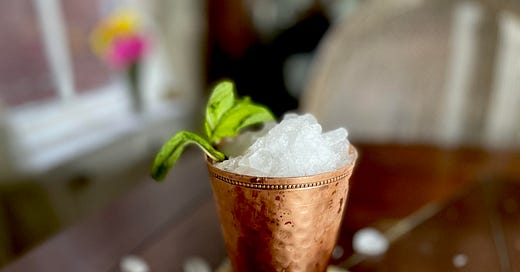Whiskey. Mint. Sugar. Crushed ice. A frosted tin cup.
The Mint Julep is practically elemental in its simplicity. Yet it is surprisingly tricky to execute well. It can, however, be done.
I am not a real Kentucky boy. I was born in Ohio and raised mostly in Florida. But I spent several formative college years in Kentucky, in the Lexington area, and I consider it a kind of second home.
So every year, when the Kentucky Derby comes around, I make a Mint Julep — or, depending on my time and tolerance for experimentation, several. And yet it was only recently that I finally produced one I found satisfactory enough to share.
I spent years trying to make a Mint Julep that I truly loved. I followed recipes. I experimented with different whiskeys and different ways of procuring mint. I obtained julep tins and old-timey tools for crushing ice. I tried adding floats of rum. I despaired and sipped straight whiskey in my frustration. I followed more recipes. I returned to despair.
At first I made a lot of Mint Juleps that were objectively bad, to the point where I’d toss them out after a few sips. After a while, I got to the point where I was making Mint Juleps that I didn’t hate, and occasionally a few I thought might be good enough. I tried them on others, who confirmed my own less-than-fully-thrilled reactions.
Good enough. Don’t hate it. That’s better than, yuck, but it was obviously not the reaction I was aiming for.
And yet I knew there was a great Mint Julep out there. There had to be, because so many people have raved about this drink for nearing two-hundred years. The Mint Julep is a drink that inspires ritual and rapture, poetry and pronouncements.
The Mint Julep was, by all accounts, a revelation. But it was a revelation that eluded me for a long, long time, in part because I didn’t quite understand what I was aiming for.
Kentucky Not On My Mind
But let’s back up a little bit, to the part where people describe this drink rapturously. From its most ancient descriptions, the Mint Julep has been hailed as so good that it is dangerous.
In his compact and delightful 1975 book, The Mint Julep, Richard Barskdale Harwell traces the origins of the drink and its place in American culture. Harwell prints what he says is the earliest account of the drink, from one Charles Joseph Latrobe, in Latrobe’s 1836 book, The Rambler in North America.
Latrobe wrote of an 1833 meeting of an Anti-Temperance Society — an attempt, naturally, to counter the potential institution of a Temperance Society — in Tallahassee, Florida. Perhaps not surprisingly, given the locale and the subject of the meeting, “great disorder prevailed.” However, as the chaos unfolded, some drinks were served, including a Mint Julep, which Latrobe described as follows:



